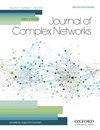Online dynamic rumour propagation model considering punishment mechanism and individual personality characteristics
IF 1.5
4区 数学
Q2 MATHEMATICS, INTERDISCIPLINARY APPLICATIONS
引用次数: 0
Abstract
In the Internet era, rumours will spread rapidly in the network and hinder the development of all aspects of society. To create a harmonious network environment, it is essential to take punitive measures against malicious rumour mongers on social platforms. Take the measure of forbidden as an example. The forbidden one may stop spreading rumours because of being punished, or he may become a disseminator again because of paranoia. Other people who know rumours may become alert and stop propagating rumours or temporarily forget rumours. And therefore, the forbidden state is added to describe the above phenomenon, and the SIFR (Ignorant–Disseminator–Forbidden–Restorer) model is proposed. Taking the vigilance and paranoia derived from punishment measures into account, the connection edges from the forbidden to the disseminator and from the disseminator to the restorer are increased in this model. And then, the stability of SIFR model is proved by using the basic regeneration number and Routh–Hurwitz stability theorem. The simulation results demonstrate that individual paranoia may do harm to the control of rumour dissemination. While the punishment mechanism, individual forgetting mechanism and vigilance can effectively curb the spread of rumours.考虑惩罚机制和个体人格特征的在线动态谣言传播模型
在互联网时代,谣言会在网络中迅速传播,阻碍社会各方面的发展。要营造和谐的网络环境,就必须对社交平台上的恶意造谣者采取惩罚措施。以禁止措施为例。被禁言者可能因为受到惩罚而停止散布谣言,也可能因为偏执而再次成为散布者。其他知道谣言的人可能会变得警觉,停止传播谣言或暂时忘记谣言。因此,添加了禁止状态来描述上述现象,并提出了SIFR(Ignorant–Dismisminator–forbidden–Restorer)模型。考虑到惩罚措施带来的警惕性和偏执性,该模型增加了从被禁止者到传播者以及从传播者到修复者的连接边缘。然后,利用基本再生数和Routh–Hurwitz稳定性定理证明了SIFR模型的稳定性。仿真结果表明,个体偏执可能对谣言传播的控制造成危害。而惩罚机制、个人遗忘机制和警惕性可以有效遏制谣言的传播。
本文章由计算机程序翻译,如有差异,请以英文原文为准。
求助全文
约1分钟内获得全文
求助全文
来源期刊

Journal of complex networks
MATHEMATICS, INTERDISCIPLINARY APPLICATIONS-
CiteScore
4.20
自引率
9.50%
发文量
40
期刊介绍:
Journal of Complex Networks publishes original articles and reviews with a significant contribution to the analysis and understanding of complex networks and its applications in diverse fields. Complex networks are loosely defined as networks with nontrivial topology and dynamics, which appear as the skeletons of complex systems in the real-world. The journal covers everything from the basic mathematical, physical and computational principles needed for studying complex networks to their applications leading to predictive models in molecular, biological, ecological, informational, engineering, social, technological and other systems. It includes, but is not limited to, the following topics: - Mathematical and numerical analysis of networks - Network theory and computer sciences - Structural analysis of networks - Dynamics on networks - Physical models on networks - Networks and epidemiology - Social, socio-economic and political networks - Ecological networks - Technological and infrastructural networks - Brain and tissue networks - Biological and molecular networks - Spatial networks - Techno-social networks i.e. online social networks, social networking sites, social media - Other applications of networks - Evolving networks - Multilayer networks - Game theory on networks - Biomedicine related networks - Animal social networks - Climate networks - Cognitive, language and informational network
 求助内容:
求助内容: 应助结果提醒方式:
应助结果提醒方式:


